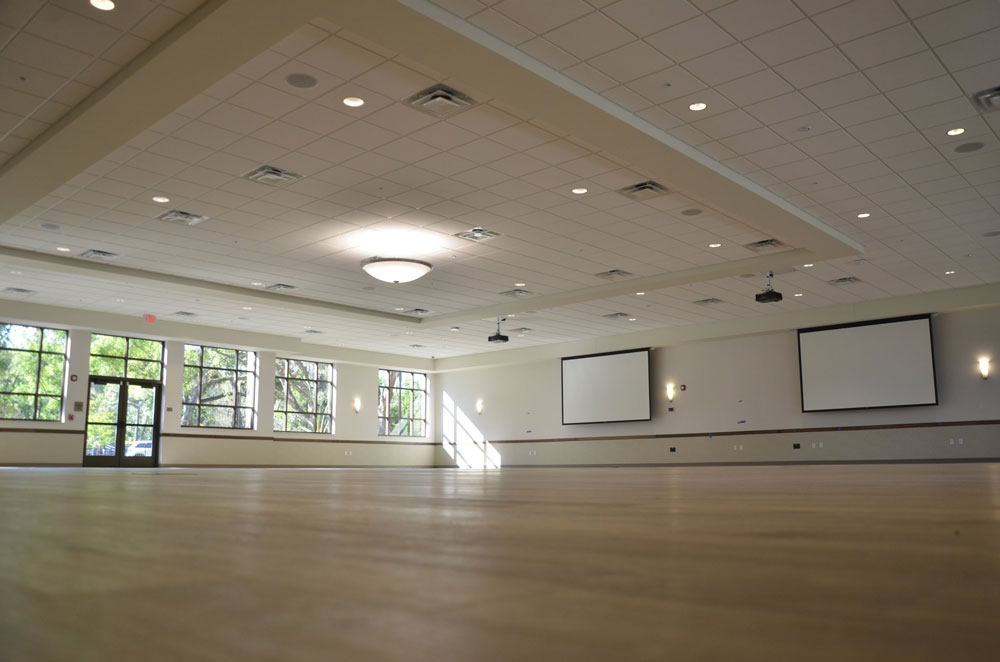
The Palm Coast Community Center has been awarded LEED certification at the silver level for the design and construction of the facility.
The LEED (Leadership in Energy and Environmental Design) rating system, developed by the U.S. Green Building Council (USGBC), is the world leading green building project and performance management system that delivers a comprehensive framework for green building design, construction, operations and performance. A plaque will be displayed in the building, which stands for leadership and demonstrates that a building has been designed, built and is operating as intended.
“We’re excited to share this innovative facility with the residents of this community as the City is committed to safe, sustainable, and green building practices,” said Director of Stormwater and Engineering Carl Cote. “The City Council has long championed conservation and environmental stewardship so achieving this certification is a testament to those core beliefs.”
The Community Center is the hub of parks and recreation for the City of Palm Coast, and offers something for all ages – activity classes, special events, and rental space for parties, weddings, business conferences and more.
The renovation and expansion project completed in 2018 tripled the size of the facility – to 21,000 square feet – and added a grand entrance and lobby area featuring a contemporary coastal design. The state-of-the-art facility was built to LEED standards for environmental sustainability and resource efficiency.
Additionally, historic oaks were preserved during construction of the playground. The basketball court was moved to the back of the grounds to allow for more parking and part of the expanded parking lot became shaded with a solar canopy.
For the certification review, the City was rated on a variety of building features. Based on the number of points achieved, each project receives one of four LEED rating levels: Certified, Silver, Gold and Platinum.
Highlights of the design and construction for which the Community Center earned points are divided into the following LEED categories:
Location and Transportation – surrounding density and diverse uses, bicycle facilities, reduced parking footprint, green vehicles;
Sustainable Sites – construction activity pollution prevention, site assessment, open space, rainwater management, heat island reduction (reduce effects on human and wildlife habitats by reducing the impact of heat retaining components);
Water Efficiency – outdoor water use reduction, indoor water use reduction, building-level water metering;
Energy and Atmosphere – fundamental commissioning and verification, minimum energy performance, building-level energy metering, fundamental refrigerant management, optimize energy performance, enhanced commissioning (verifying the training of the staff and testing to operate the energy and water systems), enhanced refrigerant management (reduce ozone depletion by minimizing the emission of harmful compounds), green power and carbon offsets (100% of the total building energy consumption is offset by the use of renewable energy sources);
Materials and Resources – storage and collection of recyclables, construction and demolition waste management planning, building life-cycle impact reduction (reuse or salvage at least 25% of the materials for the building), product disclosure and optimization – environmental product declarations (utilize products and materials that have environmental, economical, and socially preferred life-cycle impacts), product disclosure and optimization – material ingredients (Install materials that have a minimum level of recycled content), construction and demolition waste management (reduce construction waste that is disposed of in landfills);
Indoor Environmental Quality – minimum IAQ performance, environmental tobacco smoke control, enhanced IAQ strategies (utilize mechanically and naturally ventilated ideals to promote occupant comfort), low-emitting materials (reduce concentrations for chemical contaminants), construction IAQ management plan (promote the well-being of the construction workers during construction), thermal comfort (provide multiple controls of the mechanical system to the building occupants), interior lighting (provide multiple controls of the lighting to the building occupants);
Innovation – innovation (achieved a higher level of low-emitting materials and also the project will utilize environmentally sensitive cleaning products to maintain the building), LEED accredited professional (a LEED accredited professional was on the design team);
Regional Priority Credits – surrounding density and diverse uses (extra credit granted on the location of the project), thermal comfort (extra credit granted on the location of the project);
Palm Coast’s City Hall was awarded LEED certification at the Silver level in 2016 for its design and construction. Many other buildings throughout the state and country have met LEED standards. You can learn more about that at www.usgbc.org/projects/city-palm-coast-community-center-0.
![]()





























Leave a Reply